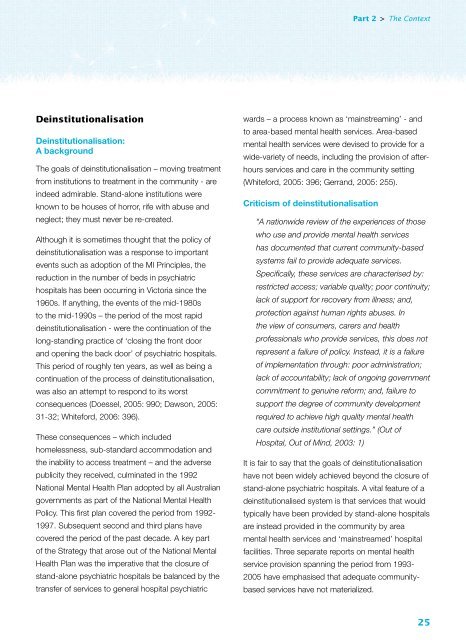Lacking Insight - Community Law
Lacking Insight - Community Law
Lacking Insight - Community Law
- No tags were found...
Create successful ePaper yourself
Turn your PDF publications into a flip-book with our unique Google optimized e-Paper software.
Part 2 > The ContextDeinstitutionalisationDeinstitutionalisation:A backgroundThe goals of deinstitutionalisation – moving treatmentfrom institutions to treatment in the community - areindeed admirable. Stand-alone institutions wereknown to be houses of horror, rife with abuse andneglect; they must never be re-created.Although it is sometimes thought that the policy ofdeinstitutionalisation was a response to importantevents such as adoption of the MI Principles, thereduction in the number of beds in psychiatrichospitals has been occurring in Victoria since the1960s. If anything, the events of the mid-1980sto the mid-1990s – the period of the most rapiddeinstitutionalisation - were the continuation of thelong-standing practice of ‘closing the front doorand opening the back door’ of psychiatric hospitals.This period of roughly ten years, as well as being acontinuation of the process of deinstitutionalisation,was also an attempt to respond to its worstconsequences (Doessel, 2005: 990; Dawson, 2005:31-32; Whiteford, 2006: 396).These consequences – which includedhomelessness, sub-standard accommodation andthe inability to access treatment – and the adversepublicity they received, culminated in the 1992National Mental Health Plan adopted by all Australiangovernments as part of the National Mental HealthPolicy. This first plan covered the period from 1992-1997. Subsequent second and third plans havecovered the period of the past decade. A key partof the Strategy that arose out of the National MentalHealth Plan was the imperative that the closure ofstand-alone psychiatric hospitals be balanced by thetransfer of services to general hospital psychiatricwards – a process known as ‘mainstreaming’ - andto area-based mental health services. Area-basedmental health services were devised to provide for awide-variety of needs, including the provision of afterhoursservices and care in the community setting(Whiteford, 2005: 396; Gerrand, 2005: 255).Criticism of deinstitutionalisation“A nationwide review of the experiences of thosewho use and provide mental health serviceshas documented that current community-basedsystems fail to provide adequate services.Specifically, these services are characterised by:restricted access; variable quality; poor continuity;lack of support for recovery from illness; and,protection against human rights abuses. Inthe view of consumers, carers and healthprofessionals who provide services, this does notrepresent a failure of policy. Instead, it is a failureof implementation through: poor administration;lack of accountability; lack of ongoing governmentcommitment to genuine reform; and, failure tosupport the degree of community developmentrequired to achieve high quality mental healthcare outside institutional settings.” (Out ofHospital, Out of Mind, 2003: 1)It is fair to say that the goals of deinstitutionalisationhave not been widely achieved beyond the closure ofstand-alone psychiatric hospitals. A vital feature of adeinstitutionalised system is that services that wouldtypically have been provided by stand-alone hospitalsare instead provided in the community by areamental health services and ‘mainstreamed’ hospitalfacilities. Three separate reports on mental healthservice provision spanning the period from 1993-2005 have emphasised that adequate communitybasedservices have not materialized.25
















